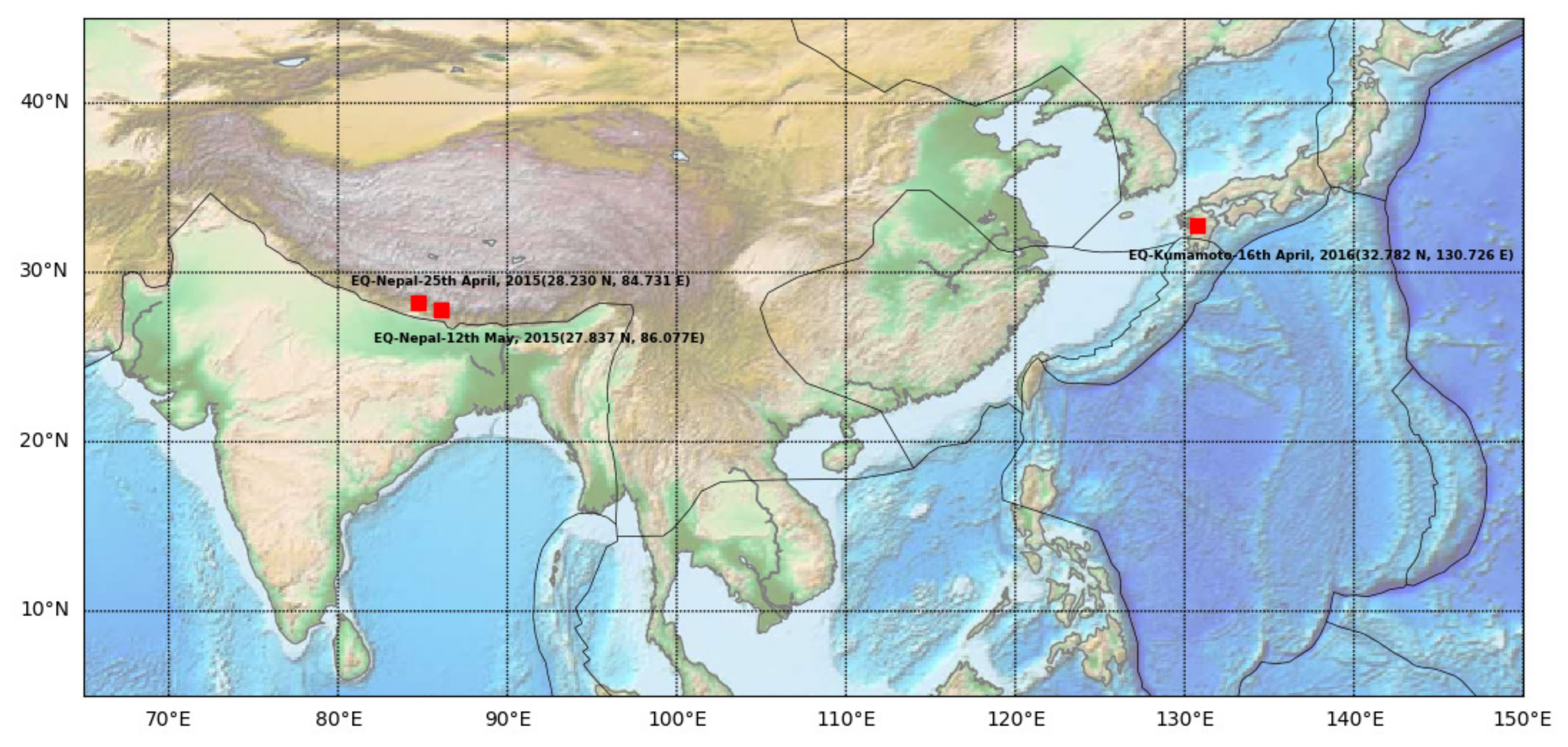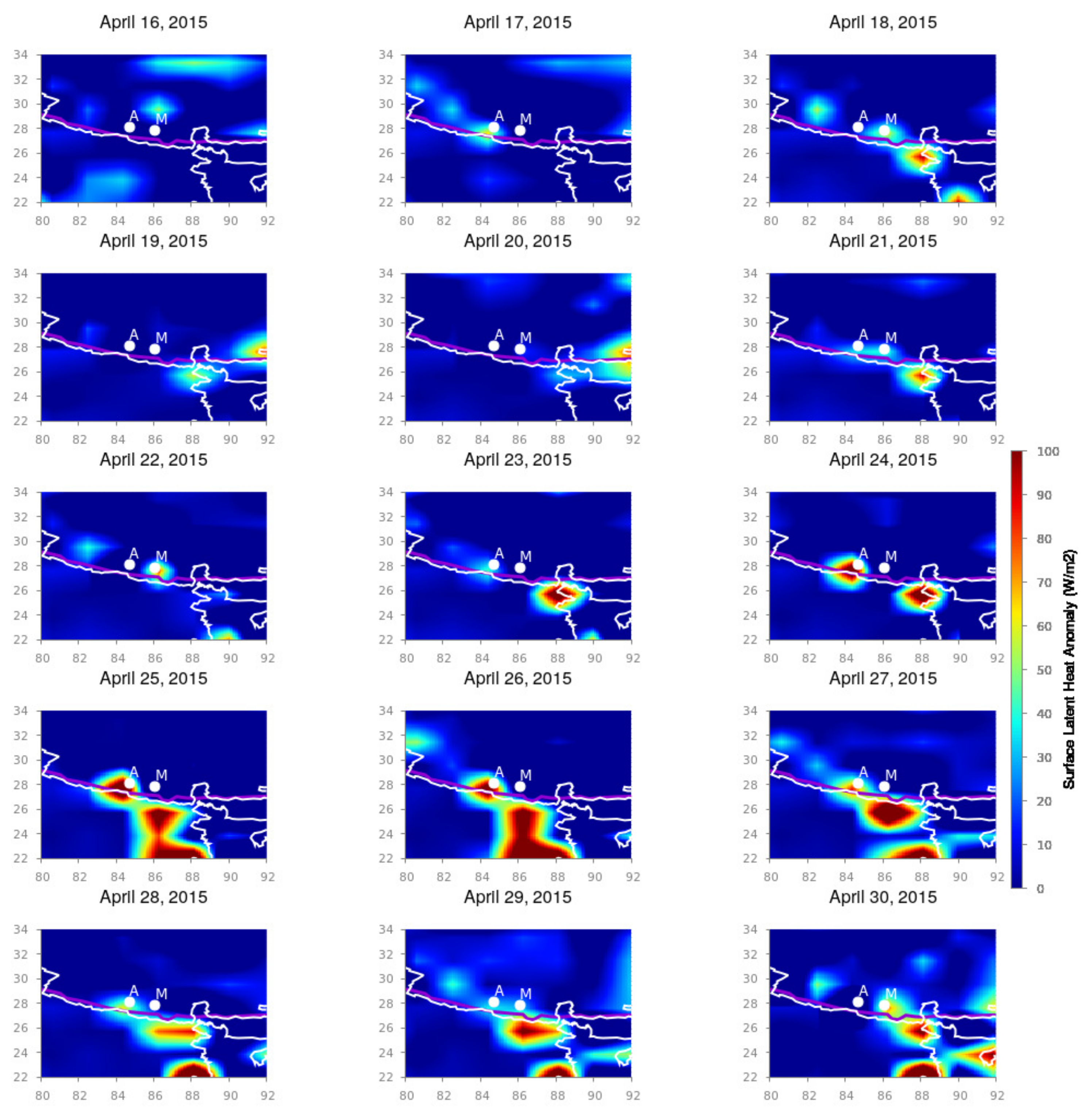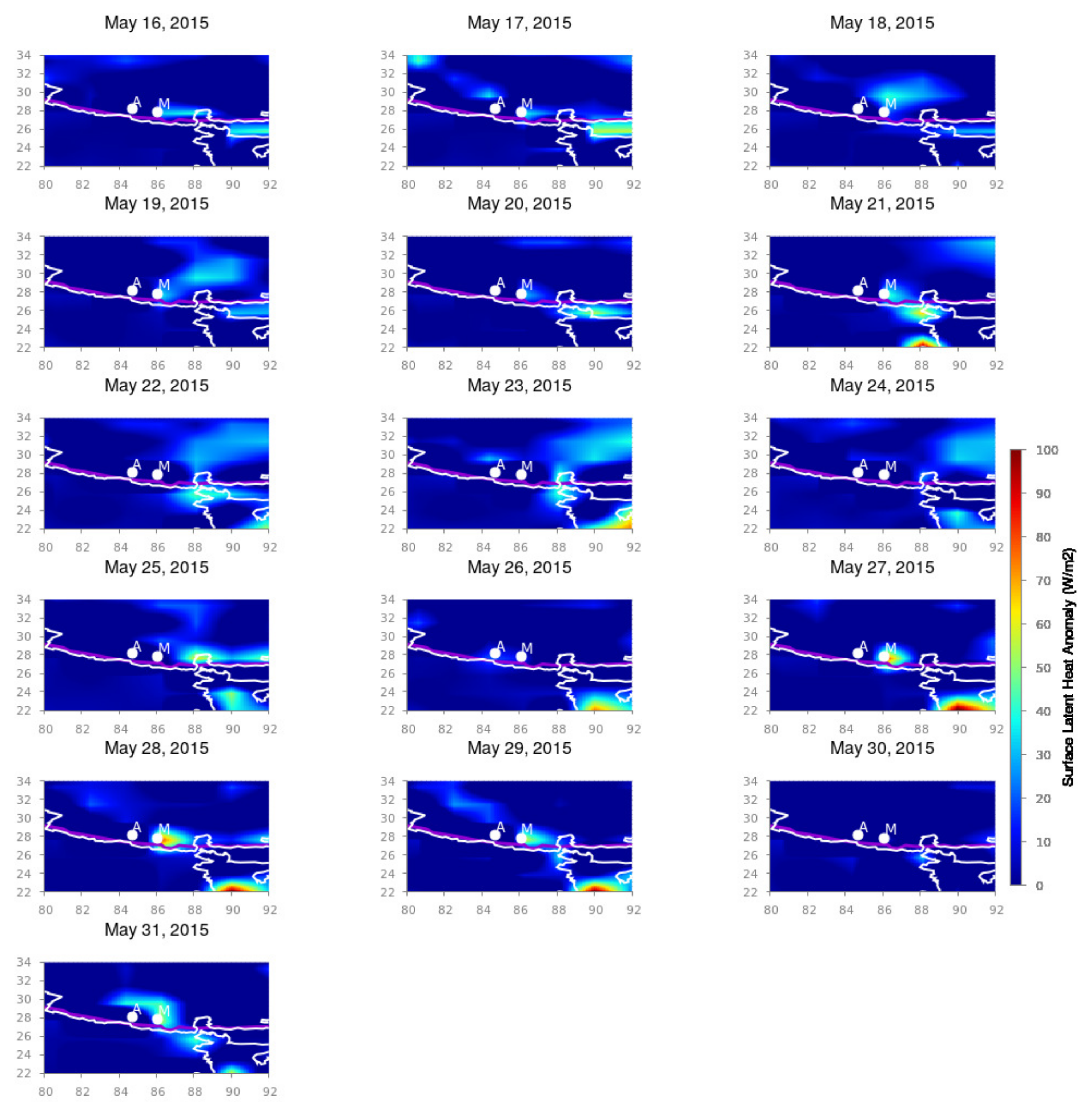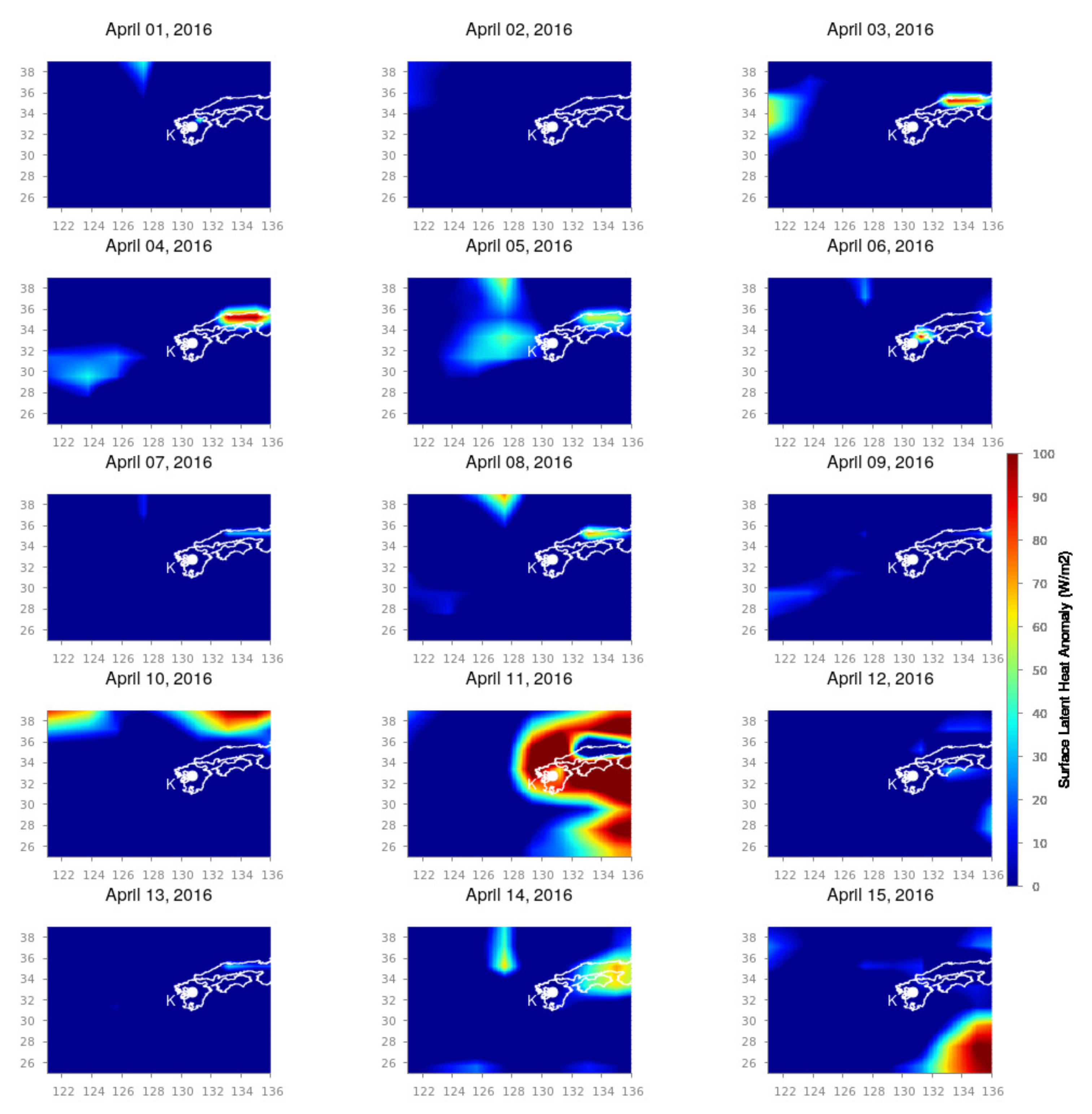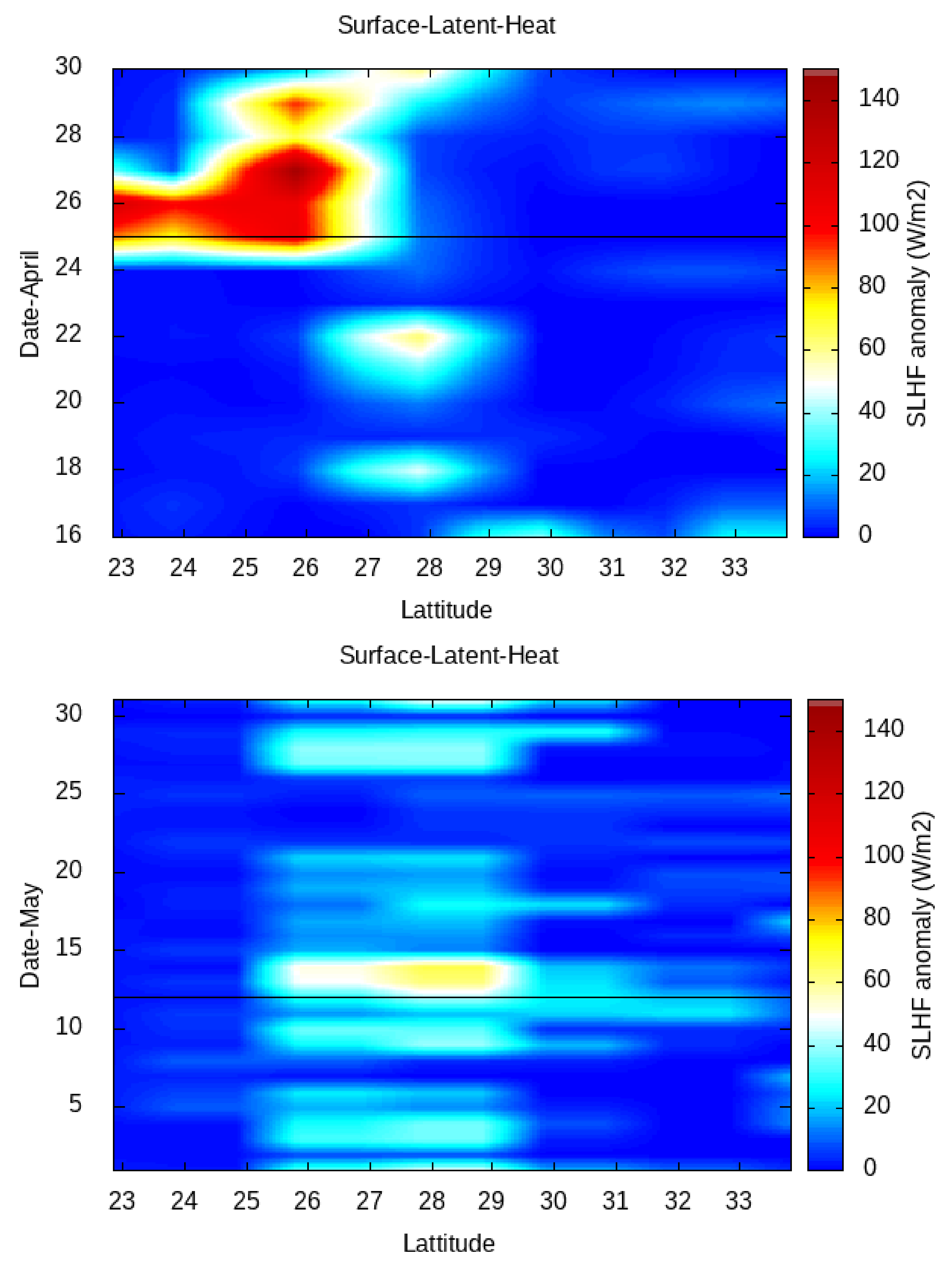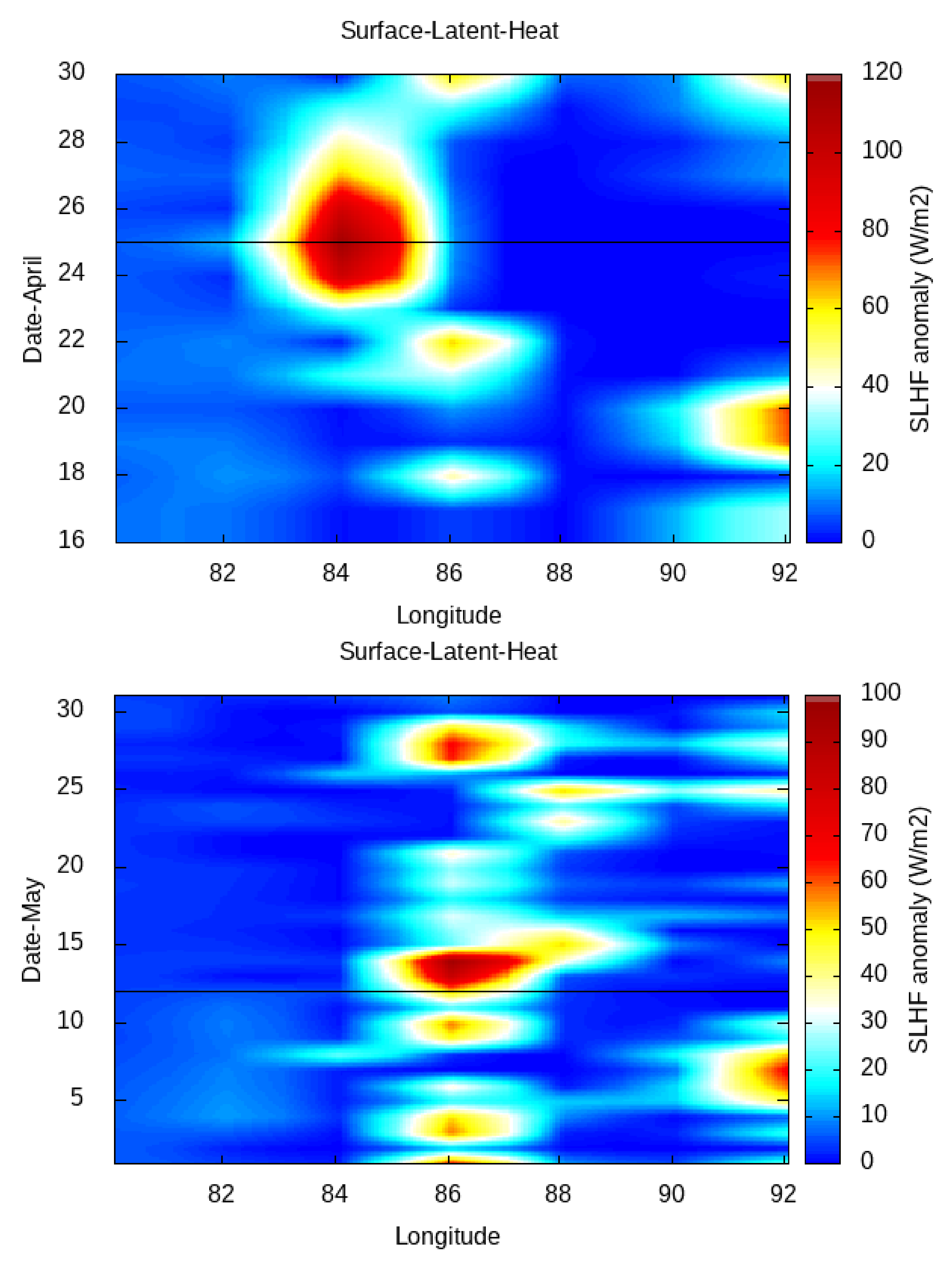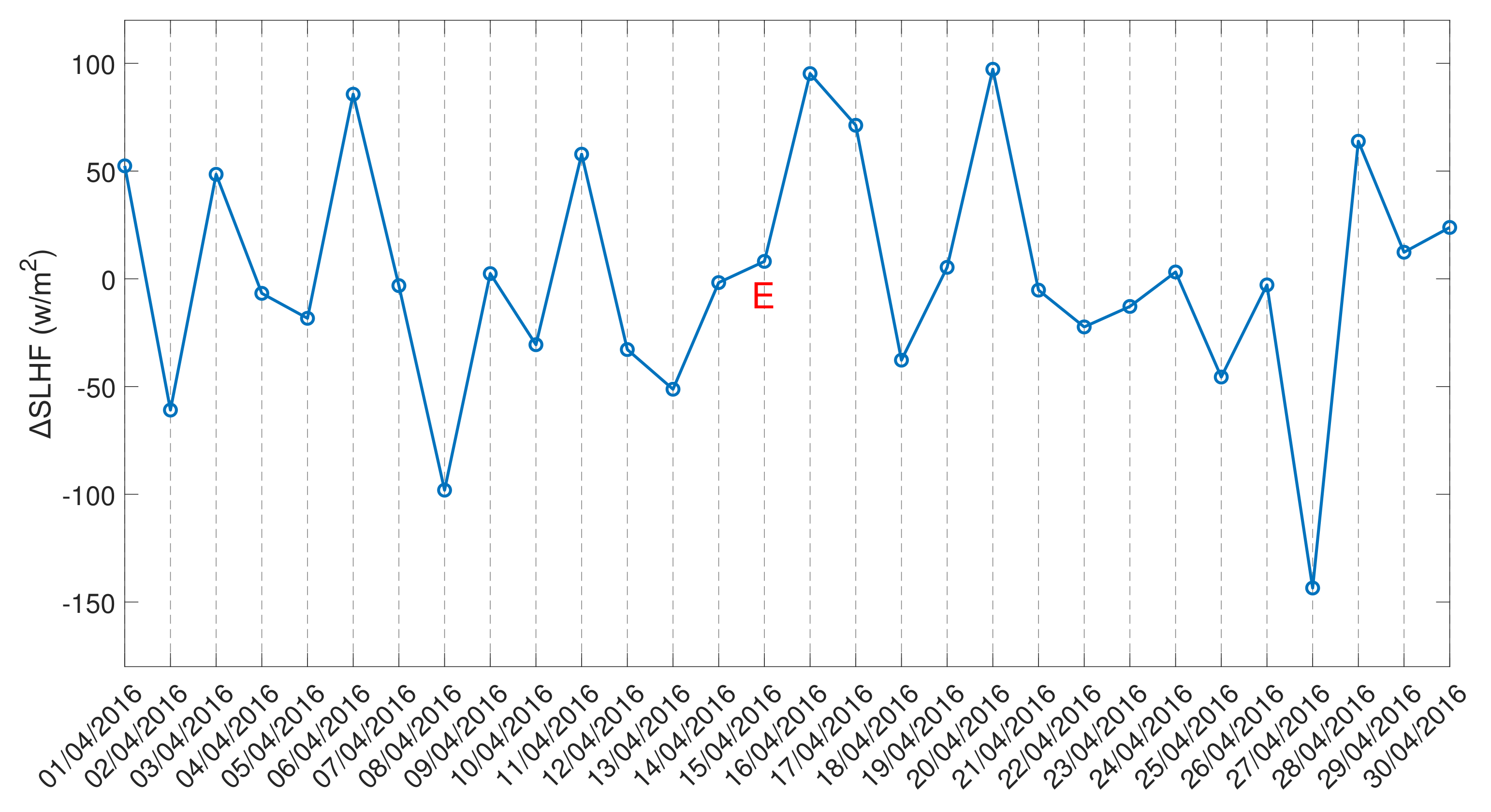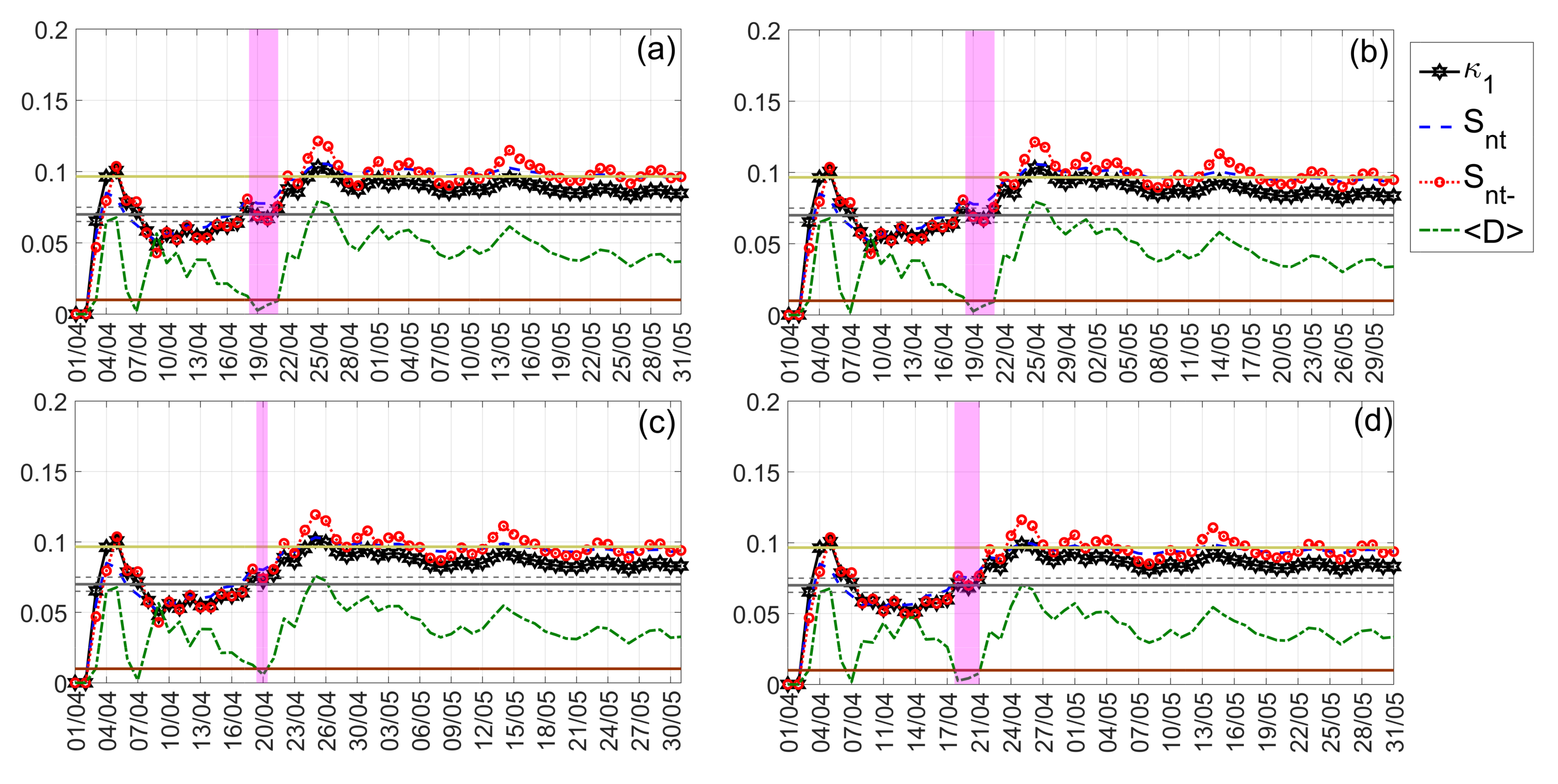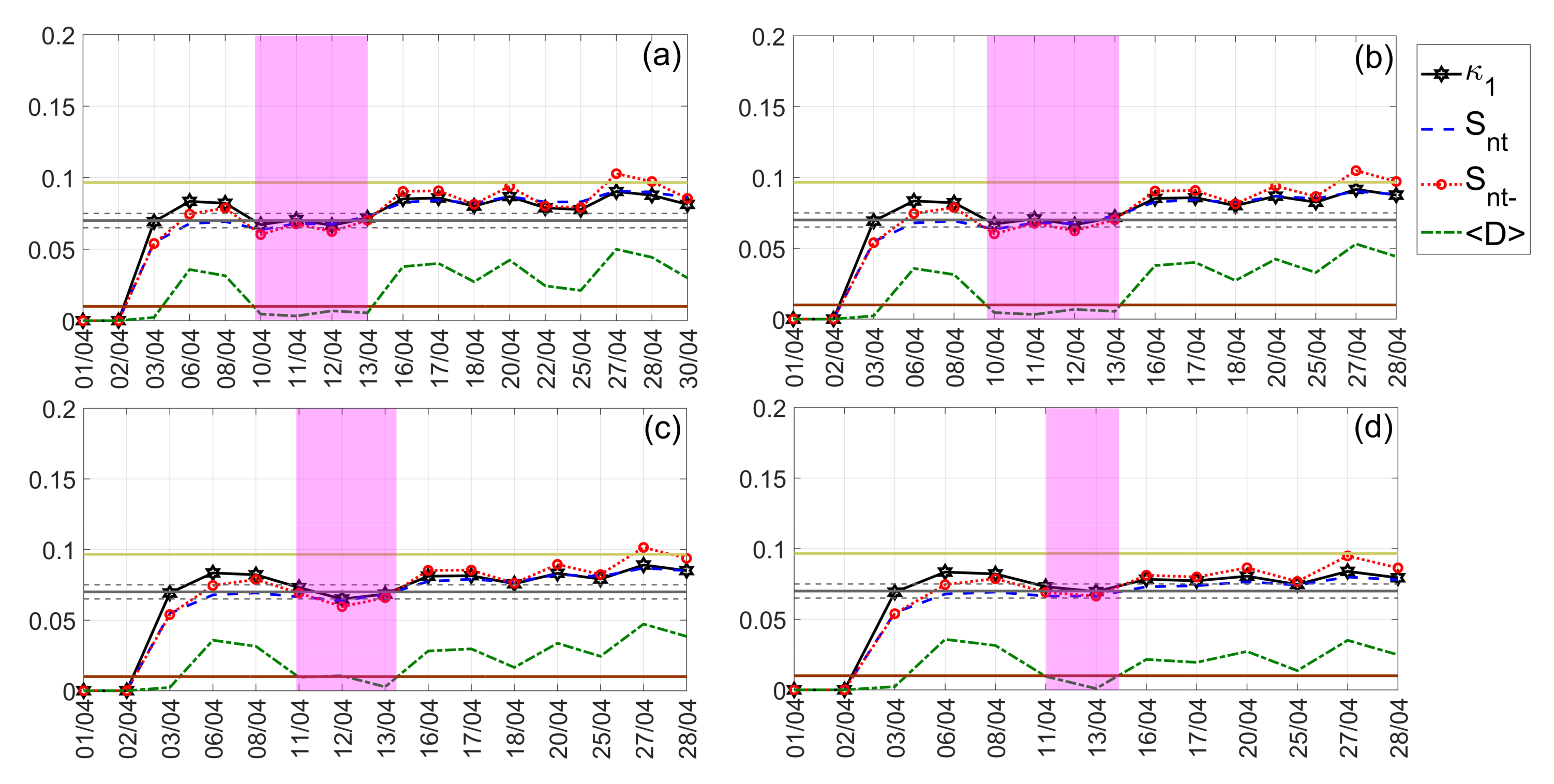1. Introduction
Earthquake prediction is one of the most challenging targets for scientists for more than a decade [
1]. Various kinds of precursory phenomena have been observed and reported before large devastating earthquakes (see Molchanov et al. [
2], Ouzounov et al. [
3], Pulinets and Boyarchuk [
4]), and those phenomena are categorized into three different types, namely, electromagnetic, acoustic, and thermal channels [
2,
5]. We have published several reports on electromagnetic and acoustic anomalies connected to earthquakes [
6,
7,
8]. In this paper, we focus mainly on the thermal phenomenon which belongs to the thermal channel and its related anomaly. The study of surface thermal anomalies will be a fundamental basis for the elucidation of the lithosphere–atmosphere–ionosphere coupling (LAIC) process as the initial agent of the LAIC mechanism. Before earthquakes, rock pressure mainly triggers a temperature increase on the land’s surface. Thermal infrared waves are emitted due to the stress accumulation arising out of this rock pressure. Ouzounov et al. [
9] and Surkov et al. [
10] found that the enhancement in thermal activities is actually due to these waves.
In the 1980s, researchers in Central Asia found a short-lived but significant signature of thermal anomalies before earthquakes from satellite images [
11]. From that point forward, numerous researchers started to study these sorts of thermal anomalies from various satellite data as an antecedent to earthquakes in China, Japan, India, Iran, and Algeria [
9,
12,
13,
14,
15,
16]. Researchers mainly concentrate on satellite data because satellite remote sensing has some advantages over traditional approaches of ground-based seismic hazard monitoring. The first advantage of satellite data is the high spatio-temporal resolution obtained from advanced satellite technology. Satellite Thermal Infrared data (TIR) are also considered to be one of the most reliable data sources as they exhibit continuity, stability, and easy accessibility of the data. Due to the high-resolution and global coverage of the continuous data, one can monitor the fast-changing and large-scale phenomena related to seismic activity with the satellite observation. In addition, it has been found, from different examinations, that satellite TIR information can uncover large-scale linear structures in addition to short term (i.e., from days to weeks) variations of thermal abnormalities over tectonic plate outskirts and active faults [
15,
17,
18,
19]. Several scientists have studied various cases of thermal anomalies from satellite data and have found a similar type of results in active seismic areas before earthquakes with moderate or strong magnitude.
To contemplate the thermal anomaly before and also at the hour of large earthquakes, we choose the meteorological parameter, Surface Latent Heat Flux (SLHF). Surface Latent Heat Flux (SLHF) is the key component of the Earth’s radiation budget. It is defined as the heat released during the phase change of matter on the earth’s surface. Heat energy is transported from the Earth’s surface to the atmosphere through the evaporation process. This evaporation process compensates for the energy loss due to the radiation processes [
20]. Moreover, the evaporation rate is higher on the ocean surface compared to the land surface. Similarly, the SLHF is also higher in the ocean than on the land. Before large earthquakes, a thermal infrared emission is observed near the epicentre [
9]. This emission of thermal infrared occurs due to the accumulation of stress in the fault regions. Due to the thermal infrared emission, the rate of exchange of energy from the surface to the atmosphere increases. As a result, the SLHF also increases before strong earthquakes [
21]. SLHF is also dependent on various atmospheric parameters such as air temperature and relative humidity. According to the LAIC mechanism, radon is the primary source of ionization in the surface area. The newly formed ions are attached to water molecules present in the air. Hence, the trend of air temperature and relative humidity varies from normal during the preparation time of the earthquakes near the epicenter. In addition, there is a growth in the ion clusters due to hydration. These cluster formations change the air conductivity and generate the anomalous electric field which, finally, changes the ionospheric potential. On the other hand, change in air temperature and relative humidity create vertical thermal convection and an air pressure gradient. Vertical thermal convection also modifies the atmospheric electric field and creates convection currents. The gradient in air pressure generates atmospheric gravity waves. All these changes in the convection current and atmospheric electric field create ionospheric perturbations. So, the change in the SLHF is a key parameter in the LAIC mechanism.
For coastal earthquakes, Dey and Singh [
21] have observed an anomalous increase in the SLHF 20 days before the earthquake. So, the SLHF anomaly can be considered as a possible precursor in giving early data about a looming seaside seismic event. Cervone et al. [
22] have developed a wavelet analysis approach to distinguish maximum peaks related to an approaching earthquake and demonstrate atmospheric disturbances. Pulinets et al. [
23] have suggested that the abnormal increase in the SLHF a few days prior to the earthquakes in coastal areas is actually due to the increase of surface temperature in a seismically prone area. For various reasons, the SLHF abnormality is fundamentally more “fragile” on the land surface than on the ocean surface. The main reasons that affect the surface latent heat anomaly are air humidity, surface temperature, and wind speed. Since there is a significant difference between sea and land surface variations of these parameters, the anomalous behavior of the SLHF is also affected. Studies of Qin et al. [
24] showed that a strange change in the SLHF occurred almost 10 days before the inland Pu’er earthquake (geographic coordinates: 23.8092
N, 101.15
E) on 2 June 2007. Though Zhang et al. [
25] found some opposite results which show that no huge irregular variation in the SLHF exists preceding around 10 cases of marine or coastal earthquakes. Hence, it is clear that in order to establish the connection between the SLHF abnormality and an earthquake’s occurrence, information exactness and boundary settings have a noteworthy role.
The significant change in the SLHF irregularity before large earthquakes is strongly identified with the underground fluid motion and the communication among the underground, the surface, and the air [
26]. Mansouri et al. [
27] indicated that water vapor reactions to seismic preparation stages follow a seismic-activated chain, which is the fundamental mechanism behind air ionization, SLHF intensification, and water vapor buildup, and this can likewise bring about the development of precipitation activity. Several authors have found that SLHF enhancement before earthquake events are keenly related to soil moisture [
21,
22]. This soil moisture is responsible for air ionization and SLHF oddities in the LAIC process. With a rise in soil moisture, there is a noteworthy change in the expansion of water condensation on recently formed ions [
28].
A few examinations propose that the thermal inconsistencies in epicentral areas and the adjunct regions before large earthquakes are identified with the expansion in both air and soil temperature at shallow layers. Temperature inconsistency demonstrated by MODIS data and from other meteorological stations is found to be near to the epicenter [
29]. The seismic distortion and fault evolution under seismic pressure changes are the main reason behind the abnormality of temperature variation [
30]. Thus, temperature anomaly is a more powerful tool in identifying thermal abnormalities than Top of Atmosphere (TOA) brightness temperature or Outgoing Long-wave Radiation (OLR), since it is less influenced by the atmosphere, which permits us to obtain a higher signal-to-noise ratio [
31,
32]. Tramutoli et al. [
33] and Tronin et al. [
15] have found temperature increments up to 5
C before seismic events in Italy, Japan, and China. For the Indian sub-continent, similar types of results were reported by the study of Ouzounov et al. [
9]. Their study using MODIS data near the active tectonic fault of the Gujarat earthquake in India (M = 7.7, 26 January 2001) revealed an abnormality in the land surface temperature and a bringing down of the sea surface temperature. Tramutoli et al. [
18] found some satisfactory results for the Izmit earthquake in Turkey (M = 7.4, 19 August 1999) by improving their 2001 technique for the analysis of thermal anomalies before large seismic events. Jing et al. [
34] reported convincing evidence of the coupling between the land, atmosphere, and meteorological parameters associated with the 2015 Nepal earthquake. In that paper, they simultaneously used the microwave brightness temperature, the surface air temperature, the soil moisture, the surface latent heat, andthe carbon monoxide profile as a multi-parametric examination of the precursory mechanism associated with Nepal earthquakes. Their study concluded that the thermal variations in the sub-surface show anomalous behavior two months prior to the mainshock, where the other anomalies appeared two weeks before.
In our study, we have chosen the Nepal earthquakes of 2015 and the Kumamoto earthquake of 2016. On 25 April 2015, at UTC 06:11:25, a strong (M = 7.8) earthquake occurred in Nepal. The epicenter was at Barpak east of the Gorkha district. After this earthquake, a chain of aftershocks hit Nepal, and again on 12 May 2015, another earthquake (M = 7.3) hit the southeast of Kodari. In 2016, a series of earthquakes hit the coast of Japan, including a magnitude M = 7.0 mainshock which struck at16:25 UTC on 15 April underneath Kumamoto City of Kumamoto Prefecture in Kyushu Region, Japan, and a foreshock of M = 6.2 at 12:26 UTC on 14 April 2016 at a depth of about 11 km. In
Figure 1, we present the location of the epicenter of the earthquakes with the main tectonic and geological features. To investigate the possible pre- and co-seismic SLHF variations, we use the conventional spatio-temporal study of the increasing SLHF by removing the background variation of non-seismic conditions. We also study the SLHF anomaly variation for these earthquakes considering the latitude and longitude of the epicenters as the center point and present the latitudinal and longitudinal variation in the SLHF for that time period. Moreover, we study the SLHF time series at the closest possible to each earthquake’s epicenter location by means of the natural time analysis [
35], a powerful time series analysis method that can unveil the approach to criticality. Our results indicate that the analyzed time series present critical dynamics within one week before each mainshock. Finally, the obtained results are discussed within the frame of LAIC.
2. Data and Methodologies
Advanced satellite technology provides high-resolution spatio-temporal global remote sensing data. Satellite Thermal infrared (TIR) data are significantly solid information source that displays the progression, dependability, and availability. This information provides the scope of investigation of large scale and rapid changing thermal irregularities associated with seismic events. Crustal deformation and related thermal information of the Earth’s interior can occur very rapidly on a perceptible scale using satellite TIR abnormality. In addition, large scale linear structure and fast-changing impermanent (i.e., from days to weeks) changes in thermal abnormalities in the outskirts of tectonic plate boundary and active faults can be uncovered by satellite TIR data. We take National Oceanic and Atmospheric Administration (NOAA) reanalysis data for Nepal and Kumamoto, Japan, earthquakes and analyze those data to study the thermal anomaly. NOAA reanalysis data are taken from
https://www.esrl.noaa.gov (accessed on 23 September 2018). NOAA Reanalysis data were created with the collaboration of other organizations and cover data from 1948 to the present day. These reanalysis datasets are created based on surface, upper-air balloon, aircraft, and satellite observations. These datasets are available in three formats: four times daily, daily, and monthly. These datasets are divided into four different classes A, B, C, and D. The A class parameters are directly obtained from observations, whereas the B class parameters are also obtained directly with strong influence from model data. C class parameters are obtained from the model. D class parameters are not dependent on model values. Now, the SLHF parameter belongs to the C class [
36]. Zonal wind, Meridional wind, and geopotential height are some class A parameters, whereas surface temperature, surface pressure, and relative humidity are class B parameters. Ice concentration is an example of D class parameter. As the SLHF parameter is not assimilated but directly derived from the model, we have not addressed the assimilation methodology in this paper. In our case studies, we choose surface level daily data. To identify the thermal anomaly related to earthquakes, we need to remove diurnal, seasonal variation, and other climatological and meteorological effects. To remove these effects, we prepare background data using the seismically quiet period for the same grid area. To compute the background data, we use the following equation:
For both, the studied cases the value of
N is 3. In the case of the Nepal earthquake, we prepared the background using the data for the years 2016, 2017, and 2018, which were seismically quiet. For Japan, we chose similar variations by using the data for 2017, 2018, and 2019 to prepare the background variation. Now, in order to extract the actual seismogenic variation, we subtract that background variation from the seismically active time period as follows:
where
is the data obtained for the seismically active time period. For the Nepal earthquake, we used the latitude range 22
N to 34
N and the longitude range of 80
E to 92
E for the spatio-temporal variation. We compute the anomaly in the SLHF parameter and overlay the world map over the results to recognize the spatio-temporal variation regarding the epicenter and earthquake fault line. For the Kumamoto earthquake, we use latitude range 25
N to 39
N and longitude range 121
E to 136
E. We also overlay the world map over the results to recognize the spatio-temporal variation regarding the epicenter and earthquake fault line. Apart from the spatio-temporal variation, in order to recognize the spatial trend of the SLHF and the possible impact of the aftershocks, we perform a separate analysis. The SLHF has been studied as a function of the day number and latitude of the earthquake epicenter with fixed longitude and vice versa. For the SLHF parameter, the latitude and longitude resolution of the raw data are taken as 1.9
and 1.875
, respectively. Interpolated data files are created with a 0.09
× 0.09
binning grid that displays a smooth spatio-temporal variation. We interpolate the gridded values of SLHF to 1
interval for both latitudinal and longitudinal profiles for the total time period of interest. We obtain such temporal variations in latitudinal and longitudinal profiles just to emphasize the expansion of the above-mentioned anomaly around the earthquake epicenter.
Finally, in order to apply the natural time analysis (see
Section 3) and check for any approach of SLHF to criticality, we need an SLHF time series at a specific geographical point. Since for the spatio-temporal analysis the spatial resolution grid has been taken as 1
× 1
, we examine the nearest grid point to each mainshock epicenter (see
Table 1). At that particular point, we find the SLHF variation along with the deviation of SLHF computed from seismically quiet years, from which we produce the daily-valued time series
. We clarify that the considered nearest grid points are within the critical radius, which, for an EQ of magnitude M7, is 200 km [
37].
3. Natural Time (NT) Analysis Method
NT time series analysis method has initially been applied to the ultra-low frequency (≤1 Hz) seismic electric signals (SES) and foreshock seismicity [
38,
39,
40] and has been shown to be optimal for enhancing the signals in the time-frequency space [
41]. Subsequently, NT analysis has been applied to various, real-world and simulated, complex systems time series to reveal their approach to criticality [
35], including several seismo-electromagnetic signals [
42], as well as air ion density anomalies [
43] and global navigation satellite system surface deformation [
44] possibly related to earthquakes and the LAIC phenomenon. In the following, we briefly present the key notions of this method. The interested reader is referred to Potirakis et al. [
42] for a detailed presentation of the practical application of NT analysis to various time series, including daily-valued ones as the here investigated
, as well as to Varotsos et al. [
35], for its full theoretical presentation.
Initially, for a number of
N events, we determine the NT of the occurrence of the k-th event as
, i.e., the conventional time information is removed, and only the order of occurrence is retained, normalized in the range [0, 1]. Next, we determine the “energy” of each event in NT, which is symbolized as
for the k-th event. At this point we have to mention that
corresponds to different kinds of quantities, depending on the time series under analysis. For example, in the case of seismic events,
is the seismic energy released (seismic moment), while for the dichotomous SES signals,
corresponds to the SES pulse duration [
40]. However, in the case of the fracto-electromagnetic emission signals in the MHz band, which are non-dichotomous signals,
denotes the energy of each event by using consecutive amplitude values above a noise threshold as described in Potirakis et al. [
45].
Then, we study the evolution of the pair of
. The approach of a dynamical system to criticality is identified by means of the variance of NT,
, where
is the normalized energy released during the k-th event. Moreover, the entropy
in NT is defined as
, which corresponds to the value for q =1 of the derivative of the fluctuation function with respect to q, fl(q) (while
corresponds to fl(2)) [
35,
46]. The entropy in NT is a dynamic entropy, depending on the order of the events [
46]. Moreover,
, the entropy under time reversal (
), is also studied [
46].
In many studied dynamical systems, it has been found that the value of
is a measure to quantify the extent of the organization of the system at the onset of the critical stage [
35]. The criticality is reached when (i)
takes the value
, and (ii) at the same time, both the entropy in NT and the entropy under time reversal satisfy the condition
[
35,
47], where
is the entropy of the uniform distribution in NT [
35,
46].
In the special case of NT analysis of foreshock seismicity [
38,
40,
41,
46,
48], we study the evolution of the quantities
, and
with time, where
is the “average” distance between the normalized power spectra
(
stands for the angular frequency in NT) of the evolving seismicity and the theoretical estimation of
for
,
. Moreover, an “event” for the NT analysis of seismicity is considered to be any data point (earthquake) of the original seismicity time series that surpasses a magnitude threshold,
.
The analysis starts with an appropriate low threshold and taking into account only an adequate number of events, first in the order of occurrence. Next, the subsequent events, in their original order, are one-by-one taken into account. For each additional event that is taken into account, the quantity is rescaled within the interval (0,1), while the normalized energy and all , and are re-calculated. This way, a temporal evolution of these quantities is attained, taking into account the current event and all preceding events. The described procedure is repeated for several, increasing values of for each studied geographic area, and everything is repeated for different overlapping areas.
The seismicity is considered to be in a true critical state, a “true coincidence” is achieved, as soon as (i)
takes the value
, (ii) at the same time both the entropy in NT and the entropy under time reversal satisfy the condition
, and three additional conditions are satisfied: (iii) The “average” distance
should be smaller than
, i.e.,
(this is a practical criterion for signaling the achievement of spectral coincidence) [
35]; (iv) the parameter
should approach the value
“by descending from above”, i.e., before the main event the parameter should gradually decrease until it reaches the critical value 0.070 (this rule was found empirically) [
35,
38]; (v) the above-mentioned conditions (i)–(iv) should continue to be satisfied even if the considered
or the area within which the seismicity is studied are changed (within reasonable limits).
The use of the magnitude threshold excepts some of the weaker earthquake events (those events that their magnitude is <) from the NT analysis. However, the usage of the magnitude threshold is valid for the reason that some recorded magnitudes (lower than a threshold) are not considered reliable due to the seismographic network. On the other hand, the application of various values is useful in determining the time range within which criticality is reached. This is because, in some cases, it is found that more than one time-points may satisfy the rest of the NT critical state conditions (i)–(iv), and criterion (v) is the one that finally reveals the true time of criticality. For the application of NT analysis to data, we follow the paradigm of the NT analysis of foreshock seismicity by using the absolute value of their daily values to define the “energy” and the necessary threshold values.
5. Conclusions
Thermal anomaly is one of the most important channels of the LAIC mechanism because it directly deals with the immediate after-effects of seismic hazards over the surface and lowermost atmospheric altitudes. Outgoing thermal radiation from the earthquake epicenter and fault lines is considered to modulate the temperature, latent heat, and relative humidity of the surface to the lower tropospheric height. In this article, a space-based observation of such thermal excitation is examined by NOAA satellite outputs. The SLHF seems to be a potent parameter of the LAIC process since significant intensification has been observed during, prior to, and after strong earthquakes. We examined such thermal behavior for three earthquakes: two that took place in Kathmandu, Nepal (25 April and 12 May 2015), and one in Kumamoto, Japan (15 April 2016). In our previous publication [
6], we have studied another thermal parameter OLRs from a similar NOAA satellite observation where the direction of such an enhanced OLR had a longitudinal extension (east–west). In contrast to the OLR, which is a directly emerging thermal wave in the infrared range, the SLHF anomaly is rather differently originated by the attachment of water molecules to thermal ions.
In this paper, it is the first time that natural time (NT) analysis is used to find the approach of the criticality of the SLHF before earthquakes. NT analysis is a physics-based method to analyze the time series of complex systems’ observables which is able to detect critical dynamics. Previously, the NT analysis method has been used on different electromagnetic parameters to identify the approach of criticality before earthquakes, e.g., [
51,
52,
53,
54]. In our study, we used NT analysis for the thermal channel of the LAIC mechanism. We found that the observed anomaly is in the same time range of the criticality approach. Our findings indicate that the atmosphere is in the critical stage before the studied earthquakes.
The criticality analysis, by means of the NT method, reveals that criticality was approached ≤1 week before each one of the studied Nepal earthquakes, specifically, 5 days before the 25 April 2015 main event and 1 week before the 12 May 2015 mainshock. Interestingly, in order to disclose the criticality dynamics related to the latter one, we had to run the criticality analysis by employing the SLHF data after the occurrence of the April 2015 event. In case all the available data (including dates even prior to the 25 April event) are used, a masking phenomenon takes place, where the critical dynamics related to the April event do not allow for the critical dynamics of the May event to be revealed. Moreover, on 15 April 2016, the Kumamoto mainshock criticality is approached 4–1 days before the earthquake. The data analysis indicates that the atmosphere was in the critical state before all the studied earthquakes.
As far as the direct pre-seismic SLHF anomalies evidence presented in this work are concerned, we have to mention that the anomalies revealed by the spatio-temporal variation analysis happened in close dates to the approach to criticality, within 1 week before each mainshock. One difference between the Nepal events and the Kumamoto event is that for the Nepal cases, criticality precedes the seismogenic spatio-temporal anomaly, while in the Kumamoto case, the opposite is observed.
Focusing on the 2016 Kumamoto earthquake, for which several statistical and criticality analyses of observables related to the LAIC process have recently been presented, we note that all the up to now studied observables (see
Section 4) were found to embed critical dynamics during the last 10 days before the mainshock, with overlapping time durations. This clearly corroborates the LAIC hypothesis since these criticality analysis results suggest that the lithosphere, atmosphere, and ionosphere were indeed coupled and can be considered as a system, and this lithosphere–atmosphere–ionosphere system is at a critical state before the mainshock occurrence. However, due to the overlaps of the criticality time periods, it is difficult for one to extract detailed cause-and-effect information.
So far in our approach, we focused on this problem and succeeded in showing the changes as well as the reasons. There are so many significant parameters associated with the thermal channel of LAIC which describe the changes of the lithosphere as the initial agent of the LAIC process. However, the exact way of understanding the reason behind those changes remains unknown. The radon emission process over the earthquake epicenter has been found to be the initial threshold of the LAIC mechanism that excites the air ionization process. The newly formed ions coagulate with water molecules, known as the ion hydration process. In addition, the cluster of ions increase and the relative humidity decreases. These processes lead to the increase in the air temperature and change in air conductivity by generating the anomalous electric field. The change in air conductivity also increase the air temperature and modify the air pressure gradient. All these processes simultaneously change ionospheric potential, create vertical thermal convection, and generate atmospheric gravity waves. To understand the entire process of the LAIC mechanism, one has to study and take into account the all-possible parameters related to the entire process. Multi-parametric and multidisciplinary approaches will able to help us to understand the LAIC process starting from the lower atmosphere to upper ionosphere [
55]. In parallel, other thermal parameters such as relative humidity, air temperature, surface temperature, cloud coverage, etc. can be utilized as a potent component of seismogenic thermal excitation. Continuous monitoring of such parameters is thus an absolute need, and we need to study those phenomena globally, as well. This will help us to grasp the entire scenario on how those physical processes are actually interrelated and propagate at the same time to produce the pre-seismic anomalies. Finally, further coordination of thermal anomalies with the information of ionospheric and magnetospheric perturbations as a multidisciplinary work will be extensively planned better to elucidate the LAIC process of our greatest concern. These will be studied in the future and will be published elsewhere.
